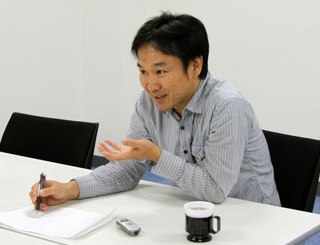Elucidating part of the DNA damage repair mechanism!

Kanji FURUYA, D. Sc., Assistant Professor,
Niki Group, Microbial Genetics Laboratory,
Genetics Strains Research Center, National Institute of Genetics/ SOKENDAI.
(Dr. Furuya moved from the NIG in Mar. 2011.)

What led you to research into DNA damage and repair mechanism?
Initially, the mechanism of checkpoint proteins which supervise chromosomal information and control cell proliferation interested me when I began contemplating my career path after graduation. This led me to six years at the University of Sussex in the UK. While I was there, I came up with the idea that the system that detects genomic DNA damage also enables cells to discern their internal and external environments. I have since been carrying out research hoping to elucidate factors involved in damage detection and damage repair mechanisms.
Checkpoint proteins detect cellular or DNA damage, arrest the cell cycle and prepare for repair. Among 11 checkpoint proteins known in fission yeast such as ATR and CHK1, I decided to focus my analysis on the structure and function of Rad9, which is located nearest the starting point of repair response, that is, immediately adjoining DNA. In 2006 I came back to Japan and joined the NIG. I have been continuing the Rad9 research using fission yeast in parallel with another project at the NIG.
Our cells are constantly exposed to internal and external stresses such as UV rays and activated oxygen from our breathing. These stresses can cause various forms of damage at the genomic level, including DNA deletion, insertion or replacement and double-strand breaks. Cell divisions repeated while damage is left unrepaired turn cells cancerous or bring about other problems, but cells can prevent them with the mechanism that constantly checks for DNA damage and prepares for immediate repair as needed. The protein Rad9 plays an important role in the activation of this mechanism and in keeping the other checkpoint proteins on DNA. Rad9 is known to exist in all eukaryotes.
What are your latest research achievements?
Rad9 is a ring-shaped protein complex composed of 426 amino acids. Before I started my research, it was already known that Rad9 constantly checks for DNA double-strand breaks and, once they are detected, bonds to the damaged section in such a way as to let DNA pass through the ring and starts preparing for repair, but the molecular mechanism of control was not known in detail. So I decided to analyze in detail the location and order of Rad9 activation and interactions with other molecules.
While I was still in the UK, using Rad9 mutant fission yeast, I explored the location of phosphorylation, which is necessary for Rad9 to perform its function. This led me to discover in 2004 three specific locations of phosphorylation on Rad9, as well as the occurrence of phosphorylation at two locations followed by Rad9 bonding to DNA, partial transformation of Rad9 construction, and phased phosphorylation at one of the three locations. I also clarified that phosphorylation occurring in this manner enables bonding of downstream checkpoint proteins to various sections of Rad9, which turns them into a protein complex.

More recently, I discovered that there are three other locations of phosphorylation, in addition to the three found earlier, that further phosphorylation of another section of Rad9 in the final step undoes bonding between Rad9 and DNA, and that repair does not proceed correctly if the bonding is not undone.
It is easier to understand this series of dynamic changes around Rad9 when it is likened to a wine opener since proteins are “tools” for cells. Step 1: the wine opener is screwed into the cork, which corresponds to bonding to damaged DNA section and the first phosphorylation. Step 2: the wine opener lever is raised to lift the cork up, which is the second phosphorylation. Step 3: the cork is removed, which corresponds to undoing the bonding between Rad9 and DNA. As in opening the wine bottle as with Rad9, it is essential that these steps proceed correctly in that order one by one. Just as wine will never be available for your pleasure if the cork is not removed, Rad9 must be removed from DNA for repair to occur. In other words, in either task, it is important that the whole process is completed to the end.
What do you think was particularly well evaluated in your published paper?
I think the most outstanding thing about my work is that it concerns one specific upstream checkpoint protein with such a detailed analysis of its control and function. There is no other such studies, while numerous checkpoint proteins have already been identified and those at downstream locations have been relatively well researched. Personally, I am satisfied that I was able to demonstrate how Rad9 activates its DNA-checking mechanism and DNA repair preparation mechanism in parallel.
What was the key to this success story?
I suppose it was firstly the use of fission yeast, whose mutant generation and analysis are relatively easy and secondly an exhaustive one-by-one approach to looking for likely locations of phosphorylation. In the experiment I only used antibodies that bonded to phosphorylated locations for a detailed analysis of mutant behavior using genetic techniques. I think only fission yeast would have allowed this analysis.
What is your next goal?
I would like to conduct similar studies using human cell strains to confirm the same mechanisms as found in fission yeast and demonstrate the universality of control.
While the Rad9-based mechanisms are found in all eukaryotes, as far as fission yeast is concerned, it can remain alive without them. In other words, Rad9 is there, although those mechanisms are not vitally important. This suggests that Rad9 has some other more important function. Considering that DNA can be damaged by oxidation stress from respiration, transcription and other vital activities on DNA and that the amount of these activities is influenced by environmental changes, I wonder if the Rad9-based mechanisms also detect environmental changes from minute changes in DNA damage during genesis or differentiation. In fact, there are reports that indicate the need for checkpoint protein activation during genesis. I am planning to carry out my research with this in mind.
(Interviewed by Naoko Nishimura on Oct. 18, 2010)
DDK phosphorylates checkpoint clamp component Rad9 and promotes release from damaged chromatin.
Furuya, K., Miyabe, I., Tsutsui, Y., Paderi, F., Kakusho, N., Masai, H, Niki, H., and Carr, AM. Molecular Cell, Nov 24, 2010. DOI: 10.1016/j.molcel.2010.10.026
Back














